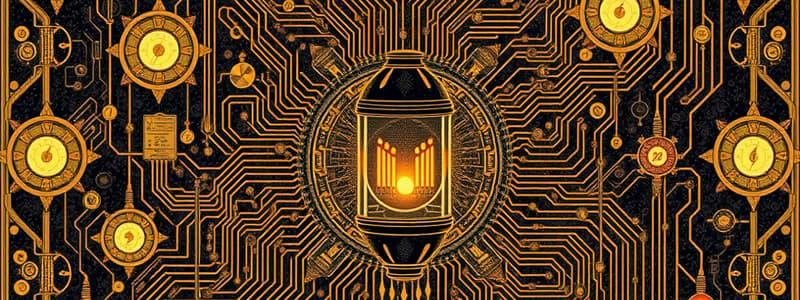Podcast
Questions and Answers
What is the primary function of a transistor?
What is the primary function of a transistor?
- Amplifying and switching electrical signals (correct)
- Generating electrical signals
- Converting electrical energy into light
- Storing electrical energy
Which terminal of an NPN transistor allows current to flow from the collector to the emitter?
Which terminal of an NPN transistor allows current to flow from the collector to the emitter?
- Emitter
- Base
- Collector (correct)
- Ground
How does the base current affect the current flow between the emitter and collector in a transistor?
How does the base current affect the current flow between the emitter and collector in a transistor?
- It causes a short circuit
- It has no impact on the current flow
- It blocks current flow completely
- It controls the larger current flow (correct)
What type of voltage is applied to the base of a PNP transistor to allow current to flow from the emitter to the collector?
What type of voltage is applied to the base of a PNP transistor to allow current to flow from the emitter to the collector?
What is the color code for the third band of a 1kΩ resistor?
What is the color code for the third band of a 1kΩ resistor?
Flashcards are hidden until you start studying
Study Notes
Transistors Overview
- Transistors serve the dual purpose of amplifying and switching electrical signals in electronic circuits.
- Common types include NPN and PNP transistors, each distinguished by their current flow direction.
Transistor Terminals
-
Emitter (E):
- In NPN transistors, current leaves through this terminal.
- In PNP transistors, current enters through this terminal.
- Typically connected to the lower voltage side of the circuit, such as ground in NPN configurations.
-
Base (B):
- Acts as the control terminal for the transistor.
- A small current or voltage applied here governs a larger current flow between the emitter and collector.
-
Collector (C):
- In NPN transistors, main current flows into this terminal.
- In PNP transistors, main current flows out of this terminal.
- Usually connected to the higher voltage side of the circuit.
Current Flow Mechanism
-
In NPN transistors:
- A small positive voltage at the base permits a larger current to transition from the collector to the emitter.
-
In PNP transistors:
- A small negative voltage at the base allows current to flow from the emitter to the collector.
Applications
- The ability to amplify or switch electrical signals makes transistors crucial in various electronic applications.
Resistors Characteristics
- A resistor limits or regulates the flow of electrical current within a circuit.
- Color coding is essential for identifying resistor values:
- For a 1kΩ resistor, the third color band (multiplier) is red.
- For a 10kΩ resistor, the third color band is orange.
Studying That Suits You
Use AI to generate personalized quizzes and flashcards to suit your learning preferences.



